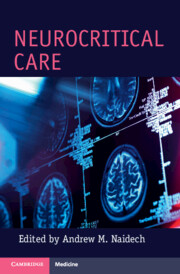Book contents
- Neurocritical Care
- Neurocritical Care
- Copyright page
- Contents
- Contributors
- 1 Introduction
- 2 Intracranial Pressure Monitoring and Management
- 3 Disorders of Temperature Regulation
- 4 Approach to Neuroimaging of the Brain, Vessels, and Cerebral Edema
- 5 Airway and Ventilator Management of the Neurologically Critically Ill Patient
- 6 Neurocritical Care Pharmacology
- 7 Intracerebral Hemorrhage
- 8 Correction of Coagulopathy
- 9 Subarachnoid Hemorrhage
- 10 Subdural Hematoma
- 11 Critical Care Management of Neurotrauma
- 12 Critical Care Management before and after Open and Intravascular Procedures
- 13 Shared Decision-Making in the Neuro-ICU
- 14 Status Epilepticus and EEG Monitoring
- 15 Evaluation of the Comatose Patient and Overview of the Brain Death Examination
- Index
- References
9 - Subarachnoid Hemorrhage
Published online by Cambridge University Press: 19 May 2022
- Neurocritical Care
- Neurocritical Care
- Copyright page
- Contents
- Contributors
- 1 Introduction
- 2 Intracranial Pressure Monitoring and Management
- 3 Disorders of Temperature Regulation
- 4 Approach to Neuroimaging of the Brain, Vessels, and Cerebral Edema
- 5 Airway and Ventilator Management of the Neurologically Critically Ill Patient
- 6 Neurocritical Care Pharmacology
- 7 Intracerebral Hemorrhage
- 8 Correction of Coagulopathy
- 9 Subarachnoid Hemorrhage
- 10 Subdural Hematoma
- 11 Critical Care Management of Neurotrauma
- 12 Critical Care Management before and after Open and Intravascular Procedures
- 13 Shared Decision-Making in the Neuro-ICU
- 14 Status Epilepticus and EEG Monitoring
- 15 Evaluation of the Comatose Patient and Overview of the Brain Death Examination
- Index
- References
Summary
This chapter discusses the management of aneurysmal subarachnoid hemorrhage patients. The sections review the epidemiology, risk factors, clinical presentation, grading scales, and important complications.
- Type
- Chapter
- Information
- Neurocritical Care , pp. 164 - 183Publisher: Cambridge University PressPrint publication year: 2022



